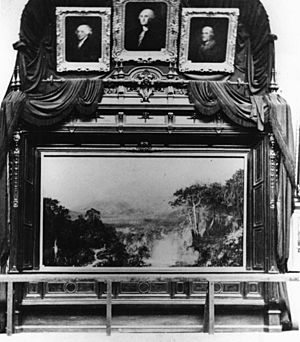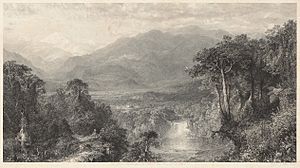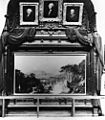The Heart of the Andes facts for kids
Quick facts for kids The Heart of the Andes |
|
|---|---|
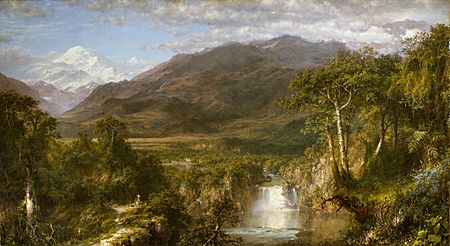 |
|
| Artist | Frederic Edwin Church |
| Year | 1859 |
| Medium | Oil on canvas |
| Dimensions | 167.9 cm × 302.9 cm (66.1 in × 119.3 in) |
| Location | Metropolitan Museum of Art, New York |
The Heart of the Andes is a very large oil-on-canvas landscape painting. It was created by the American artist Frederic Edwin Church in 1859. The painting is over 1.7 meters (5 feet) tall and almost 3 meters (10 feet) wide. It shows a beautiful, imagined scene from the Andes mountains in South America. Church had traveled there twice. When the painting was first shown in 1859, it was a huge success. It made Church the most famous landscape painter in the United States. Today, the painting is kept at the Metropolitan Museum of Art in New York. It is one of Church's most well-known artworks.
Contents
How the Painting Came to Be
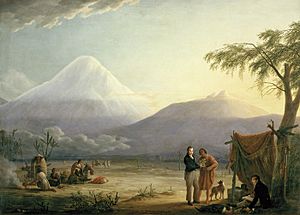
Frederic Church traveled to Ecuador and Colombia in 1853 and 1857. A businessman named Cyrus West Field paid for his trips. Field hoped Church's paintings would encourage people to invest in his South American projects.
Church was greatly inspired by a German explorer and scientist named Alexander von Humboldt. Humboldt wrote a famous book called Kosmos in 1845. In his book, Humboldt talked about how landscape paintings could help people study nature. He believed that art was a wonderful way to show love for nature. He also challenged artists to capture the true "look" of the landscape. Church followed Humboldt's travel routes in South America.
What You See in the Painting
The Heart of the Andes combines many different places Church saw during his travels. In the middle of the painting, on the right side, there is a sparkling pool with a waterfall. Far in the distance, you can see the snow-capped Mount Chimborazo from Ecuador. Darker hills in the foreground guide your eye towards the distant mountain.
You can also spot signs of people in the painting. There's a faint path, a small village, and a church in the central part of the painting. Closer to you, two local people are standing near a cross. The church is a Catholic, Spanish-colonial style building. It seems hard to reach from where you are standing in the painting.
Church even included his own signature! It is carved into the bark of a bright tree in the front, on the left side. Some people think the way light shines on his signature means that humans can control nature. However, that tree looks a bit unhealthy compared to the lively jungle around it.
Church's painting followed ideas about what makes a landscape "picturesque." This idea came from a British thinker named William Gilpin. It meant carefully looking at nature and then arranging it in a pleasing way. Mixing smooth shapes with rough ones was important. In The Heart of the Andes, you see this with the round hills and calm pool next to jagged mountains and rough trees.
The ideas of another British writer, John Ruskin, also influenced Church. Ruskin wrote a five-book series called Modern Painters about art. Many artists read his books. Ruskin believed artists should observe nature very closely. He also thought that art, good behavior, and nature were all connected spiritually. Because of this, the painting shows nature in great detail. You can see tiny leaves, birds, and butterflies up close. Then, you can see the huge natural environments Church studied. The cross in the painting suggests that religion and nature can exist peacefully together.
Showing the Painting to the World
The Heart of the Andes was first shown to the public in New York City. It was displayed from April 29 to May 23, 1859, at the Tenth Street Studio Building. This was the first building in the city designed for artists' studios. Church had shown single paintings before, like Niagara (1857), which were very popular.
This exhibition of a single painting attracted a huge crowd. More than 12,000 people paid 25 cents to see it. Even on the last day, people waited in line for hours to get in.
We don't have photos of the first exhibit. Some stories say the room was decorated with palm trees and special lights. What we do know is that the painting's frame looked like a window. It was huge, about 4.2 meters (14 feet) wide and 3.9 meters (13 feet) tall. This made the painting feel even bigger. The frame was likely made of dark wood, not the usual gold. The bottom of the frame rested on the floor. This made the painting's horizon line appear at the same level as the viewer's eyes. Curtains were hung around it, making it feel like you were looking out a real window. A skylight above the canvas made the painting seem to glow from inside. Dark cloths on the walls helped absorb light, making the painting stand out more. Visitors could even use opera glasses to see the tiny details. This might have been necessary because the room was so crowded.
The painting had a powerful effect on people. One person who saw it wrote that viewers felt dizzy and amazed. They felt a sense of being completely drawn into the painting. Its size, how it was shown, and what it depicted made them feel the amazing power of nature.
Two small books were given out with admission. They were like travel guides for the painting. They helped people explore the different parts of the landscape.
Church really wanted his mentor, Alexander von Humboldt, to see his masterpiece. He planned to send the painting to Europe. However, Humboldt died on May 6, 1859, just before the exhibition ended. So, the trip to Europe didn't happen. Church was sad, but he soon met his future wife, Isabel, at the New York exhibition.
Later in 1859, the painting was shown in London. It was popular there too. After returning to New York, it was shown again. In the next few years, it traveled to cities like Boston, Philadelphia, and Chicago. An exhibition in 1864 in New York is better documented with photographs.
Making Copies of the Painting
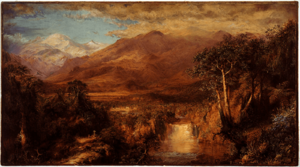
While the painting was in London, Church's agent arranged for a copy to be made. This copy would be used to create an engraving. Engravings allowed many copies of the image to be printed and sold, earning more money. A watercolor copy of The Heart of the Andes was made around this time. We don't know for sure who painted this watercolor copy. It was likely made in Britain for the engraver to use. This watercolor is now at the National Gallery of Art in Washington, D.C.
Images for kids
See also
 In Spanish: El corazón de los Andes (Frederic Edwin Church) para niños
In Spanish: El corazón de los Andes (Frederic Edwin Church) para niños
- List of paintings by Frederic Edwin Church


